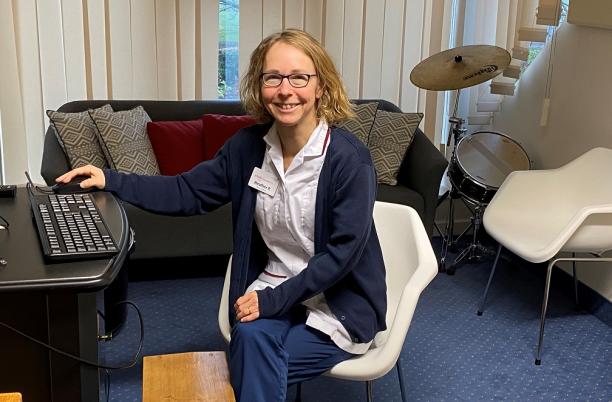

Heather Phillips, Senior Staff Nurse at Princess Alice Hospice in Esher, reflects on the impact delivering hospice care via Zoom has had on both patients and staff.
Zooming used to be something my nine-year-old did with his toy aeroplanes. As a palliative care nurse working in a hospice-based Wellbeing Centre, even the ‘Introduction to Zoom’ session I was asked to attend amidst the flurry of lockdown in late March, left me dismissive of its relevance to my practice.
Eight months on, like so many others I couldn’t do my job without it. What started as tentative contact with a few of the many patients we could no longer see in person, has grown into a thriving means of communication. Zoom sessions are an opportunity for our patients and their carers to offload, a chance for them to share stories and experiences – good or bad - and are a frequent source of humour. Some of our patients, particularly those who live alone, have described them as a lifeline.
Connecting with patients
The Princess Alice Wellbeing Centre runs at least twelve Zoom sessions a week. These include five discussion groups over three days, attended by up to eight patients each, which enable us to monitor their symptoms, address clinical problems, and refer on to other hospice services as appropriate. At times we have also been able to prompt primary care providers on behalf of our patients, for issues not directly related to palliative care.
Our discussion groups allow our patients to connect with one another, in much the same way as our previous hospice-based sessions. Time and time again I have heard patients say how much they value the support of people in a similar situation. They commiserate and celebrate together. They all have an opinion on clinical telephone consultations, ‘scanxiety’, and hospital parking. They recognise similar challenges and they suggest solutions to each other, based on their own past experiences.
Naturally this needs some careful management at times in order to maintain patient boundaries, confidentiality and safety, and our sessions are followed up with phone calls, emails and the usual documentation. Having health professionals involved offers a different dynamic from a peer-led patient support group, adding expertise and grounding, debunking the odd myth, and interpreting the jargon.
In addition, there’s room on Zoom for relaxation sessions, a physio-led seated exercise group, a breathlessness group, seated yoga, an art group, creative writing sessions, and carers groups. Ad-hoc Q&A sessions with a palliative care consultant have proved particularly popular and valuable. Our complementary therapist has been teaching calming relaxation techniques, demonstrating simple massage for specific problems, and sending aromasticks out to patients by post. A multi-disciplinary team approach adds strength and depth to our work.
From the hospice to Zoom
Zoom sessions are different from face-to-face group work. Everybody can see everybody else head on, and everyone is given specific time to speak. Often, this seems to result in a more personal sharing of information, and a deeper acknowledgement of how it really feels to be living with a life-limiting illness. Within the limits of technology and time, the groups get to know each other very well.
Another difference is that patients can keep attending virtually, even when they are extremely poorly, more so than when they had to be physically present in the building. This is good, but it can mean that their loss, when they sadly die, seems more sudden. This has an impact on the rest of the group and takes time to process. In early November the hospice chaplain joined us for a special ‘reflection’ Zoom, which was a chance to share memories of those who have died, and to acknowledge that they are missed.
The experience of hosting a session is different too. As with any group, there’s a skill to ensuring everyone has a chance to speak, and that the discussion doesn’t flounder, or wander into overly controversial territory. Again there’s a difference in being able to see everybody head on throughout the session. At times I find my eyes flicking from patient to patient. We can see when a particular comment strikes a chord with another member of the group, whether it prompts a vigorous nod or the wiping away of a tear.
Supporting each other
I wonder what it’s like for our patients when we finish a session. As colleagues we take a moment to draw breath, and we have the chance to debrief together, but this is something our patients are unable to do. No finishing of coffee, no collecting of coats, no walk down to the car park with a fellow patient with whom a particular connection has been made. We all look forward to face-to-face contact again.
Zooming is now about people rather than toy aeroplanes, but perhaps an analogy can still be made. It is a means of transporting someone from the place where they start, at the beginning of the session, to somewhere a little different at the end. A chance to gather, touch base, bring your baggage and take off.
